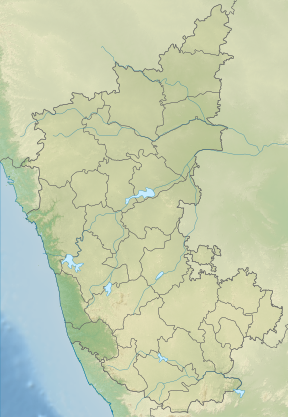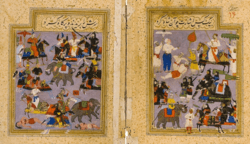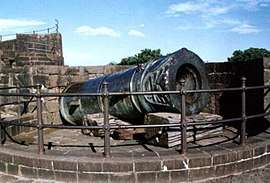Battle of Talikota
The Battle of Talikota (23 January 1565) was a watershed battle fought between the Vijayanagara Empire and an alliance of the Deccan sultanates who united in order to defeat Aliya Rama Raya. The battle took place at Talikoti, today a town in northern Karnataka, about 80 kilometres (50 mi) to the southeast from the city of Bijapur.
| Battle of Talikota | |||||||
|---|---|---|---|---|---|---|---|
| Part of Muslim conquest in the Indian subcontinent | |||||||
| |||||||
| Belligerents | |||||||
| Vijayanagara Empire | |||||||
| Commanders and leaders | |||||||
| |||||||
| Strength | |||||||
|
80,000 infantry (Beydurs)[1] 30,000 cavalry[1] several dozen artillery cannons[1] |
140,000 infantry, 10,000 cavalry and over 100 war elephants[1] | ||||||
 Location within Karnataka | |||||||
The defeat of the Vijayanagara Empire at Talikota, followed by the subsequent destruction and looting of their capital, Vijayanagara, led to the slow decline and eventual collapse of the state under the successors of Aliya Rama Raya.
Battle

The Muslim Sultanates to the north of Vijayanagara united and attacked Aliya Rama Raya's army, on 26 January 1565, in an engagement known as the Battle of Talikota.[2] The armies clashed on the plains near the villages of Rakkasagi and Tangadigi (it is also known as the Battle of Rakkasagi-Tangadi).[3][4]
The Vijayanagara army was winning the battle, but the tide turned when two Muslim commanders (the Gilani brothers) of the Vijayanagara army switched sides and turned their loyalty to the united Sultanates.[5] At this critical point of the battle, a subversive attack was launched by them. Suddenly Aliya Rama Raya found himself surprised when the two divisions in his ranks turned against him.[6] They captured Aliya Rama Raya and beheaded him on the spot, with Sultan Hussain on the Sultanates side joining them.[7][8]
Outcome

The beheading of Rama Raya created confusion and havoc in the still loyal portions of the Vijayanagara army, which led to a complete rout. The Sultanates' armies plundered Hampi and reduced it to rubble.[10]
Robert Sewell, in his book The Forgotten Empire, concludes thus – "With fire and sword, with crowbars and axes, they carried on day after day their work of destruction. Never perhaps in the history of the world has such havoc been wrought, and wrought so suddenly, on so splendid a city; teeming with a wealthy and industrious population in the full plenitude of prosperity one day, and on the next seized, pillaged, and reduced to ruins, amid scenes of savage massacre and horrors beggaring description."[11]
After the battle of Talikota, the Vijanagara Royal Family established a kingdom near Penukonda , in present-day Anantapur district of Andhra Pradesh and later in 1597 they shifted their capital to Chandragiri and ruled till 1646.[12][13]
See also
References
- India Today Collector's edition of History
- Eaton 2006, pp. 96–98.
- Sen, Sailendra (2013). A Textbook of Medieval Indian History. Primus Books. p. 110. ISBN 978-9-38060-734-4.
- Kamath, Suryanath U. (2001). A concise history of Karnataka : (from pre-historic times to the present). Jupiter Books. OCLC 634688073.
- "History vs 'Crossing to talikota' play by Girish Karnad". Firstpost. Retrieved 1 November 2019.
- K. A. Nilakanta Sastri (1955), A History of South India, Oxford University Press, p. 267, ISBN 0195606868
- Hermann Kulke; Dietmar Rothermund (2004). A History of India. Routledge. p. 191. ISBN 978-0-415-32920-0., Quote: "When battle was joined in January 1565, it seemed to be turning in favor of Vijayanagara - suddenly, however, two generals of Vijayanagara changes sides. Aliya Rama Raya was taken prisoner and immediately beheaded."
- Eaton 2006, pp. 98, Quote: "Husain (...) ordered him beheaded on the spot, and his head stuffed with straw (for display).".
- Chisholm, Hugh, ed. (1911). . Encyclopædia Britannica. 3 (11th ed.). Cambridge University Press. p. 927.
- Eaton 2006, pp. 98–101.
- "A Forgotten Empire: Vijayanagar; A Contribution to the History of India".
- Eaton, Richard Maxwell. (2005). A social history of the Deccan, 1300-1761 : eight Indian lives. Cambridge, UK: Cambridge University Press. ISBN 0-521-25484-1. OCLC 58431679.
- "The British Colonies: Their History, Extent, Condition and Resources, Volume 10".